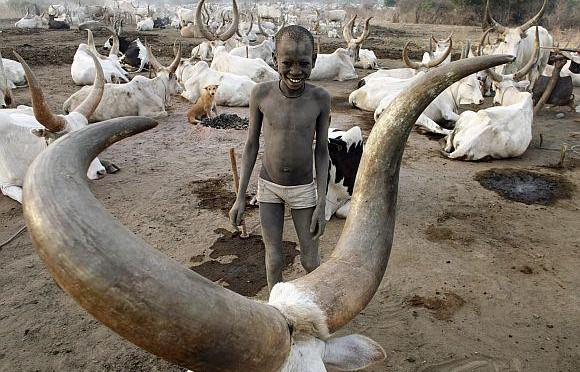It is no great revelation to any Watusi enthusiast whether a cattle owner or not that the most important and distinguishing feature of this species is the horn. Most of us are aware that the Watusi breed is composed of animals with huge, heavy and long horns. The heaviest and longest of all cattle breeds in the world. But not everyone is really aware just how difficult it is to come up with those fantastic horns.
Just because an animal is a Watusi or part Watusi does not mean that it will of necessity grow huge, long horns. It is true that the genetics of the breed will generally cause most individuals to develop better horn than other breeds, but the real value of the animal increases when they are compared with other Watusi, not with other breeds. To be exceptional when compared to others in your own breed requires a genetic quality that must be nurtured and carefully planned. With this in mind the upbreeding program was launched.
Individual Watusi breeders, in search of the ever-elusive better horn have tried various feeds, combinations of bloodlines and combinations of breeds. The results so far have been quite impressive. Overall we have developed a fine group of animals with good horn base and length. Some individual members of this crossbreeding program are now sporting what should be described as exceptional horn. There are percentage animals that will rival some of the best foundation pure and outshine many of the average foundation pure. Needless to say, heredity does play an important part here. With few exceptions the better the horned ancestors, the better the horned offspring.
It appears in most of our herds and experience that the bulls themselves sport the widest horn base, probably an evolutionary development for growth of the horn in the battles with others of their species over the cows and breeding rights. The cows as a general rule grow the most length, again probably an evolutionary development used to protect the young from predators. We enthusiasts want is all, large base and long length in both bulls and cows.
If we try to research the statistics of this breed we are very disappointed. It appears that not many scholars are even aware of the existence of Watusi (Ankole) cattle, let along have much information on them, their history, development or specifications.
Circumference of the horn base varies tremendously. Small bases would start at about 8 to 10 inches; at this circumference the horn is still slightly larger than most other breeds. Even with a base this small the length of the horn can reach great distances. I have personally measured several long horned Watusi cows and am continually shocked by what a small increase it takes to make a tremendous difference in appearance to the circumference. For instance, I have two skulls from mature Foundation Pure cows of average quality. One of these cows measures 12 inches in circumference; each horn is 36 inches in length but only 46 inches tip to tip as she was an upswept shape. The other skull measures 12.5 inches in circumference, 31 inches in length to each horn and 59.5 inches from tip to tip. This last cow impressed people as being much heavier horned than the first, with actually smaller horns and only ½ inch additional base.
We have several cows with 18-inch circumference and over 30-inch length to each horn; they walk with a rolling motion to balance these huge appendages. Photos and faraway pasture views do not do these animals justice, one needs to get close up and personal, then even 10 inches is big!
The photos that accompany this article are of two particular percentage cattle that we chose as an example of what a controlled cross breeding program can produce. The cow shown with her calf is a ¾ cross (¼ being longhorn) named Country Special bred by Zavislan Ranches. For quality this cow could stand against most foundation pure in the country, she had a good solid base, obviously long length and she is still young. A fine example of what a controlled breeding program can produce.
The second photo is a young Native Pure bull named EAP African Sam, bred by Exotic Animal Paradise. Sam is unique in that he has a horn base that is unbelievable. Still growing in breadth and length they are already 21.5 inches in circumference. The next challenge is with the offspring of this sort of quality horned individuals.
As Don Zavislan describes in his article, which is reprinted in this issue of Watusi World, there are a variety of differing horn styles, shapes, and sizes. He further points out that we need to keep complete records of our attempts at improving the breed, even or maybe especially the failures. This breed is represented by very few animals in comparison to most other breeds, which makes is all the more important that we keep track of every little scrap of information if we are ever going to be able to accurately predict what future generations will be like.

